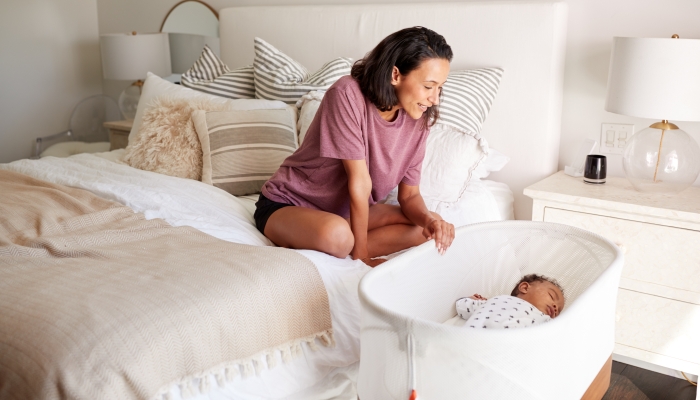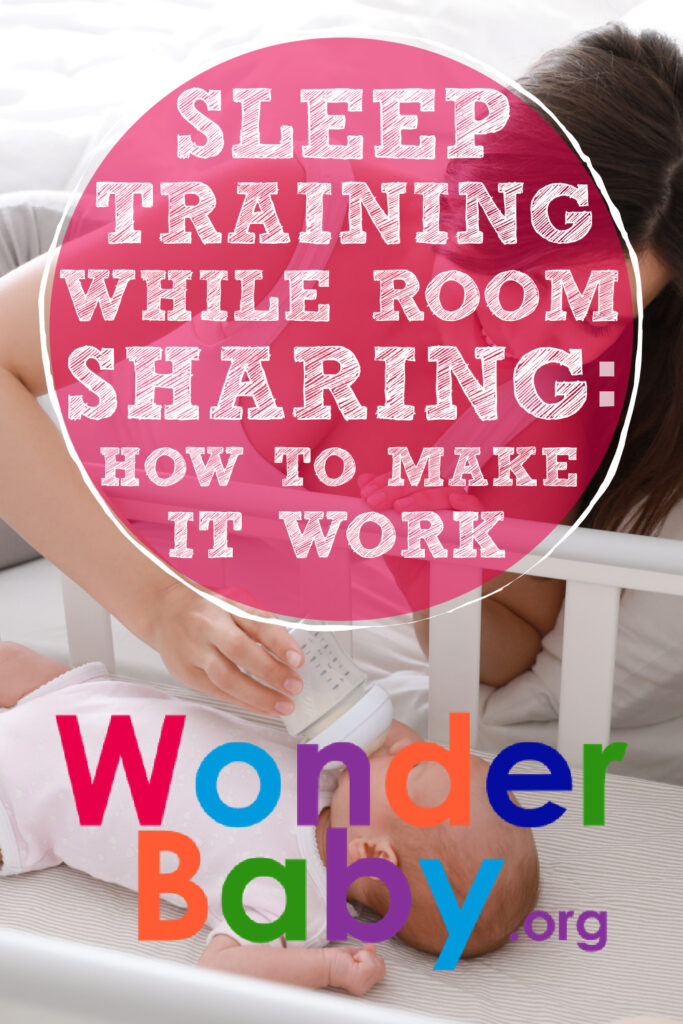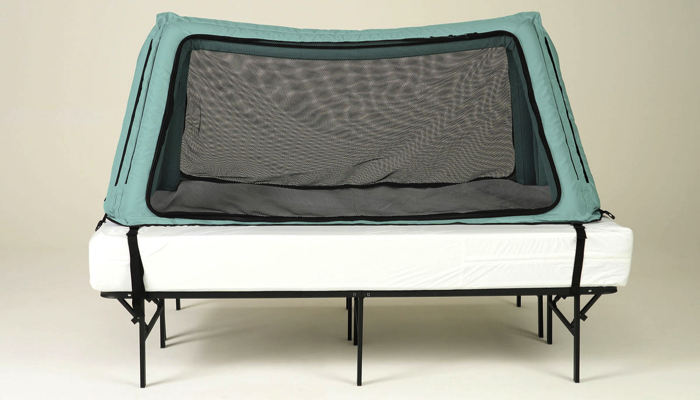Sleep Training While Room Sharing: How To Make It Work

- You can sleep train while room sharing, but it has its hurdles.
- While there are some cons, some huge pros make up for it!
- Some sleep methods may work better than others when room sharing.
- We have five tips that’ll help make the process a success!
It’s always been funny to me how much space such tiny humans can require. You start out with the crib and changing table, move onto the bouncer and high chair, and eventually accumulate more toys than you know what to do with. While that may not present much of a problem for some families, it does for those short on space.
If you find yourself lacking a designated nursery and wondering how on earth you’ll sleep train without the extra space, no worries. Sleep training while room sharing can be done with the right knowledge on board. Stay right here to find out exactly how to make it work!
Can You Sleep Train While Room Sharing?

In short, you can absolutely sleep train while room sharing, but make no mistake—it may make the process more difficult. A separate room makes it less tempting to break your training method and keeps the parent’s room private, as most would prefer. It also prevents night wakings from disturbing all involved.
Regardless, if you have to room share while sleep training, rest assured it can be done and done safely. Since they’re so close by, it can be tempting to bring your baby into the same bed, but in the end, that’s a dangerous move. Loose blankets combined with parents’ movements can be a recipe for tragedy.
Plus, while co-sleeping works for some, it’s definitely not an option when you’re sleep training. Your baby will end up using you as a prop to get themselves to sleep, much like rocking or a pacifier. What seems easy at the moment will only set you back in the long run.
Pros and Cons of Sleep Training While Room Sharing
If you’re considering sleeping training while room sharing, there are some pros and cons you’ll want to know. First, let’s look at the main advantages, a reduced risk of sudden infant death syndrome (SIDS) being one.
Researchers at The University of Tennessee College of Medicine explain in their study SIDS and Other Sleep-Related Infant Deaths11. TASK FORCE ON SUDDEN INFANT DEATH SYNDROME. SIDS and Other Sleep-Related Infant Deaths: Updated 2016 Recommendations for a Safe Infant Sleeping Environment. Pediatrics. 2016;138(5), e20162938. https://doi.org/10.1542/peds.2016-2938, “The American Academy of Pediatrics recommends a safe sleep environment that can reduce the risk of all sleep-related infant deaths.”
They go on to say, “Recommendations for a safe sleep environment include supine positioning, the use of a firm sleep surface, room-sharing without bed-sharing, and the avoidance of soft bedding and overheating.” A serious pro like this cannot go unnoticed!
Another advantage of sleep training while room sharing is the ease of feeding and comfort. If you start sleep training before the elimination of night feeds, your baby will be close by. Even better, when they’re sleep training, soothing will be inevitable at one point or another. If it’s happening often, you won’t have to go far to get to them.
Though the advantages are pretty great, there are a few disadvantages that have to be acknowledged too. Some babies will end up having difficulty transitioning to their own room once they’ve grown accustomed to room sharing. A sleep training regression can be a challenging adjustment on top of a newly learned skill like independent sleep.
The most notable con of all, though, is night waking, which is an issue for a few reasons. Parents’ movements can be too loud, waking their baby and vice versa. Also, a baby’s senses are heightened by their mom’s specific smell. That and the fact that they might be able to look over and see you are easy obstacles to getting them to sleep independently in the same room.
What Are the Best Sleep Training Methods If You Share a Room?

There are certainly more sleep training methods than those listed here, but the ones below are the best sleep training methods for room sharing. They’ve got enough flexibility to be done with you in the same room while remaining tried and true.
- Fading Method: The idea behind the fading method is to catch your baby in the sweet spot where they’re sleepy enough to get to bed without a fuss. Start by making mental notes of their sleep cues, adjusting their bedtime routine plus or minus 15 minutes accordingly. You can soothe crying if need be, then try again.
- Chair Method: The chair method has parents sitting by their baby’s crib. Offering reassurance by shushing them or little pats is fine, but parents should be as hands-off as possible, allowing their presence to be the main reassurance. Gradually move the chair back after three nights, repeating the process until there’s no longer a chair and your baby is falling asleep alone.
- Pick Up, Put Down Method: Quite literally, just as its name suggests, the Pick Up, Put Down Method has parents soothing their baby by picking them up for a short time, settling their child, and putting them back in their sleep space. This is continued until the baby falls asleep on their own.
- Ferber Method: A gentler cry it out method, the Ferber Method is a good alternative. It allows parents to check on their babies periodically, comforting them without picking them up, leaving for a certain amount of time, and repeating the process until they’ve fallen asleep. You’ll likely have to stay out of the room until they’re asleep.
How to Tell if Your Baby Is Ready for Sleep Training While Room Sharing
It can be tough to tell if your baby is ready to sleep train if you don’t know the correct signs to look for. For starters, consider their age. Parents are usually directed to start sleep training between four and six months old. At six months old, though, they have the ability to self-soothe, so some parents opt toward the higher end of that age range.
Observe if they’ve already proven they can sleep independently too. Have they fallen asleep in their own sleep space alone before? Even gotten themselves back to sleep after waking? Also, recognize if they’ve developed props like rocking or pacifiers, anything that prevents them from independent sleep. These are good signs of sleep training readiness.
Last, think about whether or not you’re truly prepared for the process. If you’re not ready to commit to sleep training, no matter how frustrating it may get, you should probably hold off until a better time.
Tips for a Successful Sleep Training While Sharing a Room

It may take some tinkering around to find out how to get your baby sleep trained when you room share, but it’s possible with the right pointers. Take the tips below into consideration when you’re working on your baby’s sleep space in your room.
- Distance: Keeping some distance between their sleep space in yours will prevent them from easy opportunities to see, smell, and hear you.
- Division: As long as it’s a safe and sturdy barrier, consider a room divider for more forced division in the room to prevent the issues mentioned above.
- Consistency: Sleep training isn’t easy, especially if you’re room sharing, so do your best to stay consistent with the training method you’ve chosen.
- Environment: Blackout curtains, a sound machine, and cool air are all part of a sleep environment conducive to getting baby sleeping.
- Camp Out: If your baby can’t fall asleep with you in your own bed nearby, consider camping out in another room until they’ve got a handle on the training method. You can sneak back in once they’re sound asleep.
FAQs
What’s the difference between room sharing, co-sleeping, and bed sharing?
These terms can tend to get intertwined, though they’re all very different from one another. To clear it up, room sharing is simply sharing the same room with your baby, not the same sleep space. Co-sleeping is sleeping on the same surface as your baby, with bed sharing, or sleeping in bed together, being one way you can co-sleep.
How can parents make the transition from room sharing to independent sleep after sleep training?
Start by spending some time in your child’s new room, especially during their bedtime routine. You can also try starting the transition during nap times. The pressure for success then is a bit less, and it’ll give you good practice for the nights to come. Soothers like pacifiers and white noise stand to make the transition a little more painless.
Reference
- TASK FORCE ON SUDDEN INFANT DEATH SYNDROME (2016). SIDS and Other Sleep-Related Infant Deaths: Updated 2016 Recommendations for a Safe Infant Sleeping Environment. Pediatrics, 138(5), e20162938. https://doi.org/10.1542/peds.2016-2938

Related Posts

Sleep, Special Needs
Safe Place Bedding Travel Bed Review
Traveling with a special needs child can be stressful! Having a safe, durable, and easy to use travel bed can make traveling so much easier!

Sleep, Special Needs
Sleep Regimen for Premature Babies: Special Considerations
It can take premature babies much longer than their full-term peers to sleep for long stretches. A preemie sleep schedule may encourage better sleep.

Sleep
Mastering the Bedtime Routine: 3 Tips for a Peaceful Night’s Sleep
From around six weeks, a newborn bedtime routine can help your baby learn the difference between day and night and prepare for a restful night’s sleep.